The Iowa Gallery, located on the mezzanine level, is the room that served as the furnished art gallery of the historic Des Moines Public Library.
Today, the Iowa Gallery is designed to tell the story of Iowa’s extensive and varied agricultural and humanitarian heritage, as well as the pride Iowans feel for their role in “feeding the world.” To preserve these marvelous stories for future generations, the World Food Prize Foundation commissioned a total of 20 new original works of art by Iowa artists to be displayed in the Iowa Gallery.
Artistic Representations of Iowa’s History
Artwork in the room includes several paintings of these great Iowans depicting their work, drawings of all the Iowans who have served as U.S. Secretary of Agriculture or chair of the Agriculture Committee, and art depicting other great Iowa humanitarian stories, such as the Yamanashi Hog Lift, Iowa SHARES refugee work, and visits from the Pope and Soviet Premier Nikita Khrushchev.
Featured Works
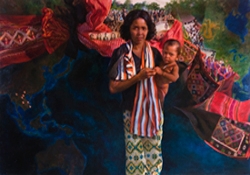
Governor Ray’s Iowa SHARES program is memorialized in this painting, which features a Cambodian refugee woman holding her hungry child. Also included in the painting are smaller-scale depictions of several other events that transpired during this period and on which then Governor Ray provided extraordinary political leadership, including providing a home in Iowa to ethnic Tai Dam refugees and saving the Vietnamese “Boat People.”
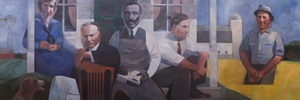
The far wall in the Iowa Gallery is entirely covered with a mural depicting Iowa’s greatest humanitarian and agricultural heroes, all gathered on Norman Borlaug’s front porch at his boyhood home near Cresco, Iowa. The figures shown are Norman Borlaug, Jessie Field Shambaugh, Herbert Hoover, George Washington Carver, and Henry A. Wallace.
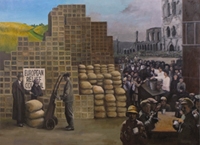
President Hoover is remembered among Iowans and throughout Europe as the man who spearheaded the feeding of hundreds of millions of hungry people during both world wars. "Food will win the war" was his rallying cry.
Herbert Hoover, born in West Branch, Iowa, came to be seen as a failed president of the United States during the Depression. In fact, he was arguably America’s single greatest humanitarian figure.
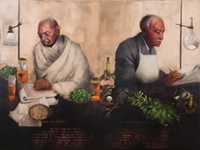
In her painting, Misol shows Gandhi and Carver, both at their desks in their offices, thousands of miles apart, writing to each other. Words from their actual letters are included at the bottom of the painting. This letter exchange took place between 1929 and 1935, as Gandhi sought advice regarding his vegetarian diet so that he could have enough strength for the long struggle that he saw coming in order to achieve the end of British colonialism.
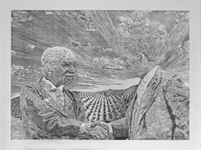
The main inspiration for this piece was a photograph of Henry A. Wallace and Carver greeting each other, although in the original photo they were not shaking hands. The background was inspired by other Midwest artists including Grant Wood and Thomas Hart Benton—the fields are reminiscent of their work in particular, and are particularly relevant to Wallace and Carver who had significant contributions to the agricultural industry. The title was taken from a quote by Carver which inspired the artist during his research of the two men.
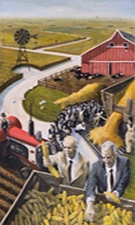
In 1959, at the height of the Cold War, Soviet leader Nikita Khrushchev declared that he wanted the Soviet Union to have its own Iowa corn belt. His statement spurred farmer and businessman Roswell Garst to invite Khrushchev to tour his farm in Coon Rapids, Iowa. Garst hoped to sell modern American agriculture – specifically hybrid seed corn – to the Soviet leader. Impressed with what he saw, Khrushchev bought tons of seed, saving millions of Soviets from extreme hunger and showing support for American agriculture and western technology. John Chrystal, Garst’s nephew, later served for four decades as an informal ambassador of agriculture to the Soviet Union, making numerous trips and contributing to further easing of tensions between the two superpowers.
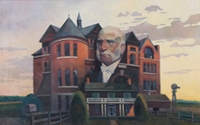
The second president at Iowa State University is depicted with Morrill Hall and the Farm House, two of the most historic buildings on the Iowa State campus. Nestled in the center of Iowa State University, the Farm House Museum sits as a monument to early Iowa State history and culture as well as a National Historic Landmark.
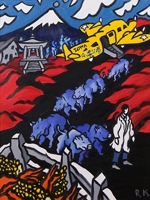
In 1959, two typhoons struck Yamanashi Prefecture in Japan, where Mt. Fuji is located, devastating its animal husbandry industry. U.S. Air Force Master Sergeant Richard Thomas, an Iowa native who was stationed in Japan, realized the possibility that his home state could help rebuild this essential economic element.
He contacted individuals in Iowa associated with Iowa Corn Growers and Iowa Pork Producers. With the leadership of Walter Goeppinger, the President of the National Corn Growers, the idea for the Yamanashi Hog Lift was born – By which, the U.S. Air Force would deliver 36 hogs to Japan.
Arrangements were made for the hog lift across the Pacific on a U.S. Air Force plane. A significant amount of Iowa corn was contributed in order to feed the hogs en route. Given the state of the aircraft industry at the time, the plane had to make multiple refueling stops along the way, at each of which the hogs would be removed from the plane and watered down to keep them cool.
Additional Artwork
In addition to all of the above works, three paintings by Iowa artist Genie Hudson Patrick are on display. The first two paintings are designed to tell the story of the change in Iowa’s topography from the original prairie, which covered the state, to the beauty that is conveyed as the soil is cultivated for agricultural production.
The four walls of the Iowa Gallery are also inscribed with additional names and concepts that have played a very special role in Iowa’s history. Recognizing Iowa's Native American history, the eastern wall is decorated by three words in the Ioway tribe's language, including "tanji," meaning prairie. The Iowa Gallery simultaneously celebrates modern Iowa heroes, including Kate Shelley, the 15-year-old Iowan that prevented a train accident, saving 200 lives, as well as John Froelich, inventor of the first gas-powered tractor.
To fully experience the artwork and history within the Iowa Gallery, please visit us in person.

